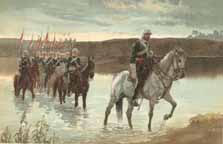"We could subdue the mutiny of 1857, formidable as it was, because it spread through only a part of the army, because people did not actively sympathize with it, and because it was possible to find native Indian races who would fight on our side. But the moment a mutiny is but threatened, which shall be no mere mutiny, but the expression of a universal feeling of nationality, at that moment all hope is at an end, as all desire should be at an end, of our preserving our Empire." — Sir John Seeley (quoted by Tarling)
The 1857 rebellion, which began with the mutiny of Indian troops stationed near Delhi, had several chief results:
- a year-long insurrection that changed attitudes -- both British and Indian — towards British rule of India
- dissolution of the British British East India Company
- beginning of the British Raj, the period during which the U. K. directly ruled the Indian subcontinent
- the end of the Mughal Empire after the British exiled Emperor Bahadur Shah to Burma
The revolt, mutiny, or rebellion, which some have seen as the first Indian war of independence, began on May 10, 1857. According to "The Uprising of 1857: A Great Divide in South Asian History" [US Library of Congress website],
Indian soldiers of the British Indian Army, drawn mostly from Muslim units from Bengal, mutinied at the Meerut cantonment near Delhi, starting a year-long insurrection against the British. The mutineers then marched to Delhi and offered their services to the Mughal emperor, whose predecessors had suffered an ignoble defeat 100 years earlier at Plassey. . . . The insurrection was sparked by the introduction of cartridges rumored to have been greased with pig or cow fat, which was offensive to the religious beliefs of Muslim and Hindu sepoys (soldiers). In a wider sense, the insurrection was a reaction by the indigenous population to rapid changes in the social order engineered by the British over the preceding century and an abortive attempt by the Muslims to resurrect a dying political order.
After the mutineers (or patriots) finally surrendered on June 20, 1858, the British ended both the East India Company and the Mughal Empire, sending the deposed Emperor Bahadur Shah to exile in Burma. With the coming of the Raj, a British governor general (or "Viceroy" as he was known when representing the British crown) ruled India, and he in turn reported to the secretary of state for India, a member of Prime Minister's cabinet (LoC Website).

India 1858. [Click on thumbnail for larger image]
The mutiny, which ended by destroying the Mughal Empire, had major effects on the U. K. as well, forcing the British government to assume direct control over the Indian subcontinent. At home, many English, who felt betrayed by peoples they thought they had befriended, experienced the revolt as a trauma. Newspapers of the period emphasized atrocities, particularly toward women and children, committed by the rebels, and these became the subjects of very well known contemporary paintings.
Bibliography
Tarling, Nicholas. Nations and States in Souutheast Asia. Cambridge: Cambridge University Press.
Last modified 7 August 2007